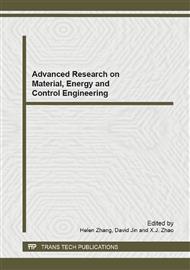[1]
Yang Bao-An, Zhang Ke-jing: Multi-objective Decision Analysis. Shang Hai: DONGHUA UNIVESITY RESS(2008).
Google Scholar
[2]
Li Jia, Zhang Peng-zhu, Deng Sha-sha: Research on automated facilitation in group support systems. Journal of management Sciences in China, 2010(12): 34-45.
Google Scholar
[3]
Wei-Lun C, Yi-Ping L, Yu-Ting H: A Heuristic Model of Network-Based Group Decision Making for E-Services[C]. (2009).
Google Scholar
[4]
Li J, Lin J, Jin Y, et al: Development of the Decision Support System for Software Project Cost Estimation[C]. (2008).
Google Scholar
[5]
Gang L, Yanni W, Xianyong W, et al: Quantitative Evaluation of Oil and Gas Resources: A Geological Analogy Model Based on Delphi Method[C]. (2009).
Google Scholar
[6]
Wang Jian-Qiang, Gong Lan: Interval probability stochastic multi-criteria decision-making approach based on set pair analysis. Control and Decision. 2009(12): 1877-1880.
DOI: 10.1109/ccdc.2008.4597558
Google Scholar
[7]
Li Zheng-Yi, Zeng Xue-Lan, Qin Ju-Ying: Clustering Analysis of Maximizing Deviation Feature Weighting Fuzzy C-partitions. Fuzzy Systems and Mathematics. 2008(4): 170-174.
Google Scholar
[8]
Ren Jing-Xi,Geng Jin-Hua,Gao Qi-Sheng. Quality optimization of the multi-factor and multi-index product. Journal of Shandong University(Engineering Science). 2007(3): 114-117.
Google Scholar
[9]
Wang Jian-Qiang, Gong Lan: Interval probability fuzzy random multi-criteria decision-making approach based on expectation-hybrid entropy. Control and Decision. 2009(7): 1065-1069.
DOI: 10.1109/ccdc.2008.4597558
Google Scholar
[10]
Xu Jiu-Ping, Wu Wei: Multiple attribute decision making theory and methods [M]. Bei Jing: Tsinghua University press, (2006).
Google Scholar
[11]
Feng Ya-Chang, Gao Jin-Yuan, Li Lu-YU: Aircraft flying qualities. Bei Jing: National Defense Industry Press, (2003).
Google Scholar
[12]
Chinese Matlab Forum: 30 Case analysis neural network using MATLAB . Bei Jing: Beihang University Press, 2010: 286.
Google Scholar
[13]
Song Hai-Zhou, Wang Zhi-Jiang: Balance between the objective weight and the subjective weight . Technoeconomics & Management Research. 2003(3): 62.
Google Scholar
[14]
Xu Ye-Jun, Da Qing-Li: An Objective and Subjective Synthetic Approach to Determine Weights Based On Ideal-Solution for Multi-attribute Decision Making [J]. Industrial Engineering and Management. 2005(4): 45-47.
Google Scholar
[15]
Xu Ye-jun: Research on Interactive Determining Weights Based on BP Neural Network and Its Application, SOUTHEAST UNIVERSITY, (2005).
Google Scholar
[16]
Deb K, Pratap A, Agarwal S, et al. A fast and elitist multiobjective genetic algorithm: NSGA-II. Evolutionary Computation, IEEE Transactions on. 2002, 6(2): 182-197.
DOI: 10.1109/4235.996017
Google Scholar


